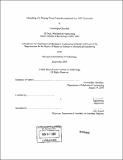| dc.contributor.advisor | Joseph L. Smith, Jr. | en_US |
| dc.contributor.author | Chaudhry, Gunaranjan | en_US |
| dc.contributor.other | Massachusetts Institute of Technology. Dept. of Mechanical Engineering. | en_US |
| dc.date.accessioned | 2006-08-25T18:55:23Z | |
| dc.date.available | 2006-08-25T18:55:23Z | |
| dc.date.copyright | 2005 | en_US |
| dc.date.issued | 2005 | en_US |
| dc.identifier.uri | http://hdl.handle.net/1721.1/33903 | |
| dc.description | Thesis (S.M.)--Massachusetts Institute of Technology, Dept. of Mechanical Engineering, 2005. | en_US |
| dc.description | Includes bibliographical references (p. 81). | en_US |
| dc.description.abstract | A single stage of a 3-stage Collins-type cryocooler designed to provide I W of cooling at 10 K was constructed and tested. A single stage of the cryocooler consists of a compressor, a counter-flow heat exchanger, and an expander to expand the working fluid. The work of the expanding cold gas is transmitted up a floating piston and is dissipated by gas flows in and out of a warm volume. Flow through the cold volume is controlled by smart electromagnetic valves. Models were developed to describe the thermodynamic processes that make up the expander cycle. In the first iteration, models were developed to determine the equilibrium states at various points in the cycle by assuming the thermodynamic processes that made up the expander cycle to be quasi-static. These models were used to determine appropriate values of parameters such as the cut-off volume, the recompression volume, and warm end reservoir pressures for expander operation. Experiments were done to determine the efficiency of the floating-piston expander. Tests were also done to determine the characteristics of the heat exchanger and compare them with the design characteristics. Finally, the stage was run as a refrigerator with zero heat-load. It was observed that the quasi-static models did not adequately describe the performance of the expander as most of the processes did not go to equilibrium. | en_US |
| dc.description.abstract | (cont.) Therefore, these models were improved by incorporating the dynamics of the piston motion, the fluid flow through the warm and cold volumes, and the fluid flow through the high-pressure passages of the heat exchanger. | en_US |
| dc.description.statementofresponsibility | by Gunaranjan Chaudhry. | en_US |
| dc.format.extent | 111 p. | en_US |
| dc.format.extent | 5998679 bytes | |
| dc.format.extent | 6003275 bytes | |
| dc.format.mimetype | application/pdf | |
| dc.format.mimetype | application/pdf | |
| dc.language.iso | eng | en_US |
| dc.publisher | Massachusetts Institute of Technology | en_US |
| dc.rights | M.I.T. theses are protected by copyright. They may be viewed from this source for any purpose, but reproduction or distribution in any format is prohibited without written permission. See provided URL for inquiries about permission. | en_US |
| dc.rights.uri | http://dspace.mit.edu/handle/1721.1/7582 | |
| dc.subject | Mechanical Engineering. | en_US |
| dc.title | Modelling of a floating piston expander employed in a 10 K cryocooler | en_US |
| dc.title.alternative | Modeling of a floating piston expander employed in a 10 K cryocooler | en_US |
| dc.type | Thesis | en_US |
| dc.description.degree | S.M. | en_US |
| dc.contributor.department | Massachusetts Institute of Technology. Department of Mechanical Engineering | |
| dc.identifier.oclc | 66528603 | en_US |
